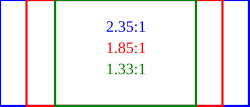Interlacing vs. progressive-scan systems
Video can be interlaced or progressive. In progressive scan systems, each refresh period updates all scan lines in each frame, in sequence. When displaying a natively progressive broadcast or recorded signal, the result is the optimum spatial resolution of both the stationary and moving parts of the image. Interlacing was invented as a way to reduce flicker in early mechanical and CRT video displays, without increasing the number of complete frames per second. Interlacing retains detail while requiring lower bandwidth compared to progressive scanning. [10] [11]
In interlaced video, the horizontal scan lines of each complete frame are treated as if numbered consecutively and captured as two fields: an odd field (upper field) consisting of the odd-numbered lines and an even field (lower field) consisting of the even-numbered lines. Analog display devices reproduce each frame, effectively doubling the frame rate as far as perceptible overall flicker is concerned. When the image capture device acquires the fields one at a time, rather than dividing up a complete frame after it is captured, the frame rate for motion is effectively doubled as well, resulting in smoother, more lifelike reproduction of rapidly moving parts of the image when viewed on an interlaced CRT display. [10] [11]
NTSC, PAL, and SECAM are interlaced formats. In video resolution notation, 'i' denotes interlaced scanning. For example, PAL video format is often described as 576i50, where 576 indicates the total number of horizontal scan lines, i indicates interlacing, and 50 indicates 50 fields (half-frames) per second. [11] [12]
When displaying a natively interlaced signal on a progressive scan device, the overall spatial resolution is degraded by simple line doubling—artifacts, such as flickering or comb effects in moving parts of the image, appear unless special signal processing eliminates them. [10] [13] A procedure known as deinterlacing can optimize the display of an interlaced video signal from an analog, DVD, or satellite source on a progressive scan device such as an LCD television, digital video projector, or plasma panel. Deinterlacing cannot, however, produce video quality that is equivalent to true progressive scan source material. [11] [12] [13]














